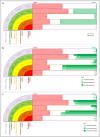A secondary analysis of the childhood obesity prevention Cochrane Review through a wider determinants of health lens: implications for research funders, researchers, policymakers and practitioners
- PMID: 33563281
- PMCID: PMC7874658
- DOI: 10.1186/s12966-021-01082-2
A secondary analysis of the childhood obesity prevention Cochrane Review through a wider determinants of health lens: implications for research funders, researchers, policymakers and practitioners
Abstract
Background: Randomised controlled trials (RCTs) are often regarded as the gold standard of evidence, and subsequently go on to inform policymaking. Cochrane Reviews synthesise this type of evidence to create recommendations for practice, policy, and future research. Here, we critically appraise the RCTs included in the childhood obesity prevention Cochrane Review to understand the focus of these interventions when examined through a wider determinants of health (WDoH) lens.
Methods: We conducted a secondary analysis of the interventions included in the Cochrane Review on "Interventions for Preventing Obesity in Children", published since 1993. All 153 RCTs were independently coded by two authors against the WDoH model using an adaptive framework synthesis approach. We used aspects of the Action Mapping Tool from Public Health England to facilitate our coding and to visualise our findings against the 226 perceived causes of obesity.
Results: The proportion of interventions which targeted downstream (e.g. individual and family behaviours) as opposed to upstream (e.g. infrastructure, environmental, policy) determinants has not changed over time (from 1993 to 2015), with most intervention efforts (57.9%) aiming to change individual lifestyle factors via education-based approaches. Almost half of the interventions (45%) targeted two or more levels of the WDoH. Where interventions targeted some of the wider determinants, this was often achieved via upskilling teachers to deliver educational content to children. No notable difference in design or implementation was observed between interventions targeting children of varying ages (0-5 years, 6-12 years, 13-18 years).
Conclusions: This study highlights that interventions, evaluated via RCTs, have persisted to focus on downstream, individualistic determinants of obesity over the last 25 years, despite the step change in our understanding of its complex aetiology. We hope that the findings from our analysis will challenge research funders, researchers, policymakers and practitioners to reflect upon, and critique, the evidence-based paradigm in which we operate, and call for a shift in focus of new evidence which better accounts for the complexity of obesity.
Keywords: Action mapping; Childhood obesity; Intervention design; Prevention; Whole systems approach; Wider determinants of health.
Conflict of interest statement
THMM, TB, and CS were involved in the Cochrane Review on “Interventions for Preventing Obesity in Children”. JN was involved in the development of the Public Health England Action Mapping Tool and the broader Whole Systems Obesity programme. The authors have no other competing interests to declare.
Figures

References
-
- Organisation for Economic Co-operation and Development . The Heavy Burden of Obesity. Paris: OECD Publishing; 2019.
-
- Butland B, Jebb S, Kopelman P, McPherson K, Thomas S, Mardell J, et al. In: Tackling Obesities: Future Choices – Project report. Foresightet al., editors. London: Government Office for Science; 2007. p. 164. - PubMed
-
- Dahlgren G, Whitehead M. Policy strategies to promote social equity in health. Copenhagen: World Health Organisation; 1991.
Publication types
MeSH terms
Grants and funding
LinkOut - more resources
Full Text Sources
Other Literature Sources
Medical
Miscellaneous

